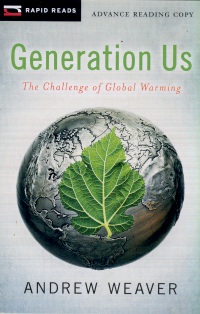| ________________
CM . . .
. Volume XVII Number 32. . . .April 22, 2011 
 |
Generation Us: The Challenge of Global Warming. (Rapid Reads).
Andrew Weaver.
Victoria, BC: Raven Books/Orca, 2011.
123 pp., pbk., $9.95.
ISBN 978-1-55469-804-2.
Subject Headings:
Readers (Adult).
High interest-low vocabulary books.
English language-Textbooks for second language learners.
Global warming.
Grades 10 and up / Ages 15 and up.
Review by Joanne Peters.
***½ /4
|
| |
|

excerpt:
These days it seems hardly a day goes by that we don't hear mention of the topic of global warming . . . It's on the news and in the newspapers. It's even in daily conversation with friends. Every time there is a flood, a drought, a heavy snowfall or strong winds someone somewhere blames it on global warming. And someone tells us that there's nothing to worry about – these are just freak weather events. So who is right? Is global warming a natural phenomenon? Can we blame individual weather events on global warming?
Politicians may choose to ignore it, grass-roots activist groups may organize to combat it – whatever the response, the scientific community agrees that global warming is real and that its pace is accelerating. So how did Planet Earth get itself into such hot water (because the oceans are definitely warming up, too)? In Generation Us, Andrew Weaver, one of Canada's top climate scientists, offers a discussion of the complexities of global warming, a discussion which is both concise and comprehensive. A climate scientist with impressive credentials and a co-recipient of the 2007 Nobel Peace Prize, Weaver begins the book by asking, "What is the problem?"
Establishing how scientists use the scientific method to validate the existence of a phenomenon – in this case, global warming – Weaver goes on to explain global warming, the Greenhouse effect, as well as greenhouse gases and their sources, both natural (volcanic activity and decomposition) and human. Industrialization has accelerated human-produced greenhouse gases, not only due to fossil combustion, but also due to such industrial processes as the production of concrete and natural gas, the agricultural use of chemicals, and, of course, transportation. As for bizarre changes in weather patterns, Weaver explains how scientists use climate models to detect and attribute the evidence that "things are heating up" (37), resulting in rising sea levels, changes in precipitation patterns, and threats to ecosystems.
In Part Two, Weaver poses the question, "Why should I care?" Even though we hear about it all the time, and may be concerned about global warming, for the most people, "it's unlikely they will spend much time wondering how global warming is affecting them now or how it will affect them in the years ahead . . . [even though] global warming is an issue that spans generations." (50-51) Global warming is an issue that has profound social dimensions and will ultimately necessitate adaptations in city planning and agriculture. Weaver counters business and economic arguments against efforts to reduce greenhouse gas emissions with questions about the morality of saddling future generations with having to cope with the problem and to "pay" for current inaction. Human health will also be affected, and a new type of refugee – the environmental refugee, displaced because of shortages of arable land, potable water or other resources – pose serious threats to social and political stability.
However, Weaver believes that it's not all hopeless. The third and final section of the book, "What can I do about it?" examines both technological and behavioral solutions to the global warming problem. And, difficult as behavioral change can be for humans, changes are possible. "Putting a price on greenhouse gas emissions" (84) is one possibility; electing political leaders who "possess and articulate a vision for a sustainable future" (103) is another. In short, all of us must move from being "Generation Me" to "Generation Us," acting locally but thinking globally.
Generation Us is amongst Raven Books' first venture into nonfiction in its "Rapid Reads" series. The text is presented in a larger-sized font, enhancing its readability, but it's not an easy read. The book does not "sound" like the presentation of an academic paper, but Weaver's arguments are presented with, and supported by, scientific information, and both the tone and vocabulary of the book assume a fairly informed reader. A Glossary at the end of the book defines words and terms which are bold-faced throughout the textual content. Less helpful are charts and graphs used to offer statistical and graphical support. The small physical size of the book means that graphs and charts are small, too, and the explanatory captions are rendered in a very small, often hard-to-read font. Grey-toned shading used in some graphs makes it difficult to see or interpret relationships presented in bar graphs, such as the one indicating the relationship between global warming impacts versus future average global temperature increases.
However, these are small quibbles in an otherwise excellent resource. Teachers and students in senior high (grades 10 through 12) science, geography, and environmental science courses will find this is a useful resource, and senior high school libraries will probably want to acquire more than one copy for their collections.
Highly Recommended.
A recently retired high school teacher-librarian, Joanne Peters lives in Winnipeg, MB.

To comment
on this title or this review, send mail to cm@umanitoba.ca.
Copyright © the Manitoba Library Association. Reproduction for personal
use is permitted only if this copyright notice is maintained. Any
other reproduction is prohibited without permission.
NEXT REVIEW |
TABLE OF CONTENTS FOR THIS ISSUE
- April 22, 2011.
AUTHORS |
TITLES |
MEDIA REVIEWS |
PROFILES |
BACK ISSUES |
SEARCH |
CMARCHIVE |
HOME |
